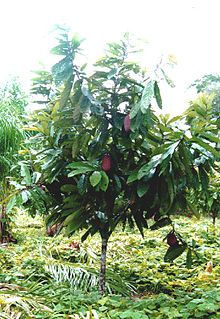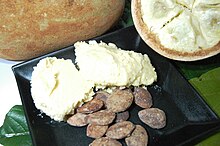Theobroma grandiflorum
Theobroma grandiflorum, commonly known as cupuaçu, also spelled cupuassu, cupuazú, cupu assu, or copoazu, is a tropical rainforest tree related to cacao.
[2] Native and common throughout the Amazon basin, it is naturally cultivated in the jungles of northern Brazil, with the largest production in Pará, Amazonas and Amapá, Colombia, Bolivia and Peru.
[2] The pulp of the cupuaçu fruit is consumed throughout Central and South America, especially in the northern states of Brazil,[3] and is used to make ice creams, snack bars,[4] and other products.
Pollinators, which include chrysomelid weevils and stingless bees, are unable to fly between flowers in heavy rains.
[8] The white pulp of the cupuaçu has an odour described as a mix of chocolate and pineapple and is frequently used in desserts, juices and sweets.



